|
BULB LOG 32 10th August 2005
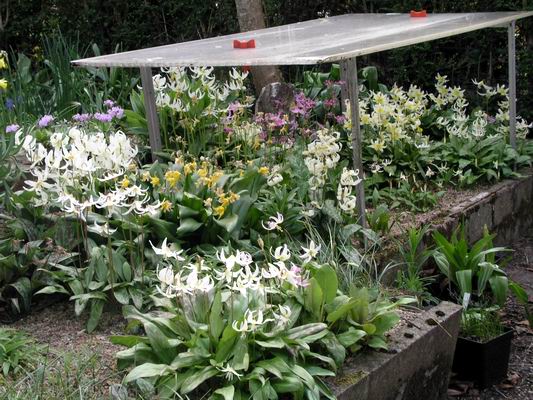
Erythroniums
Oh, what a lovely reminder of spring, with the erythroniums in the sand plunge bed at their peak of blooming.

Erythronium sand plunge
This same bed does not look so attractive just now, but it still has its delights, I just have to dig to find them. I usually try and repot these erythroniums, plunged in the plastic mesh baskets, every two years. I see these plunges as a half way house between pots and the open garden so they do not require repotting every year, which is best if they were grown in a pot, because they can root out into the sand plunge and soil below. Another reason that I have to repot every other year is that the roots from the hedges and near by trees find their way up into the rich potting medium full of nutrients and leaf mould and will suck all the goodness out of it. This is not entirely a bad thing as the trees and shrubs do not use much moisture in the early spring when the bulbs are growing and require it, but they do take up all available water during the summer when the bulbs are dormant.

Erythronium bulb escaping
I have to lift the baskets out cautiously as it is not just the roots that can penetrate into the sand below. You can see above; the bulbs will push down through even the finest of meshes so I have to check the sand underneath to look for bulbs.

Erythronium bulb half in half out
Occasionally I find a bulb has formed half in the pot and half out like this one with the constricted waist. I had to carefully cut the mesh to extricate this bulb - sometimes this is not possible and you just have to break the bulb in two. This is not as disastrous as it sounds because one part of the broken bulb will always grow on and sometimes you get lucky and both halves will produce a bulb.

Erythronium bulbs at bottom of basket
I tip the basket upside down onto my repotting bench. Most of the bulbs will be near the bottom if they are not all flattened hard against it like those above, in an attempt to get as deep as possible. The mass of roots you can see in this picture are tree roots.

Erythronium revolutum bulbs
Looking at erythronium bulbs always fascinates me they have an intriguing structure. I am using 'bulb' as a general term because I have never been able to find out definitively if Erythroniums have bulbs or corms: either people do not know or have different views - I favour corms but they also share characteristics with bulbs.
These are bulbs of Erythronium revolutum, note that each is slightly different. The centre one has a short chain which is made up of the remnants of the previous years bulbs, the left hand one has a truncated chain from which rise secondary bulbs - offsets- while the right hand one has almost no chain but a tiny offset that will eventually form a second bulb.
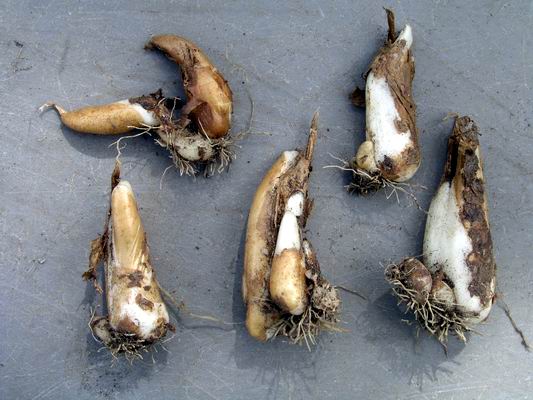
Erythronium revolutum bulbs 2
A further group of Erythronium revolutum bulbs shows yet more variations on this theme. Getting a good form of Erythronium revolutum that will increase well by division is one of my ambitions but until then the main way to increase stock is by seed. I have some forms that I have isolated that do clump up slowly but unfortunately they do not have the forms that have the best marked leaves or good dark coloured flowers.

Erythronium revolutum bulbs repotted
Here is one basket being repotted; note that the bulbs are placed as deep as possible with just a centimetre or two of compost below them.
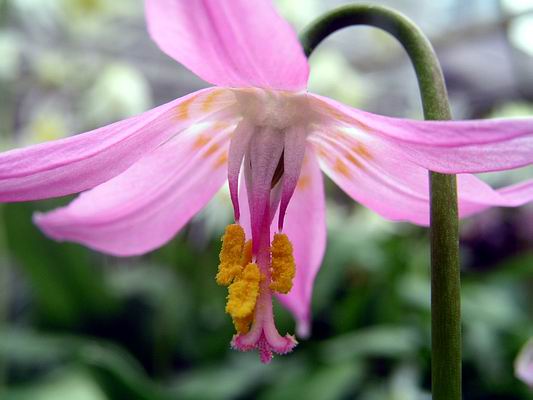
Erythronium revolutum flower
To remind you what the flower of Erythronium revolutum is like, here is a nice form that exhibits purple colouration on the style and filaments. One of the main diagnostic features used to identify revolutum is the wide filaments that look like Dutchman's breeches. The filaments are the part of the flower that holds the pollen away from the petals.

Erythronium revolutum flower parts
Not such a well marked flower but it shows the dissected out parts, this form has a white style and filaments. On the left are the three inner petals at the base of which you can see another diagnostic feature used by the taxonomists, the swollen appendages where nectar is produced. Note the small channel running down the petal from this area: does this allow the nectar to flow down the petals to further attract pollinators to the flower?
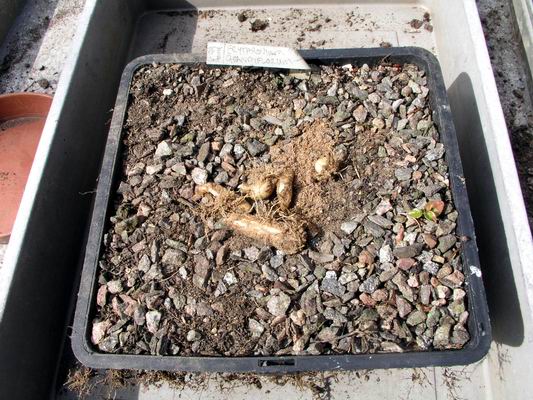
Erythronium grandiflorum basket
Under this basket of Erythronium grandiflorum I found several bulbs that had escaped into the sand, which I have placed on top for the picture.
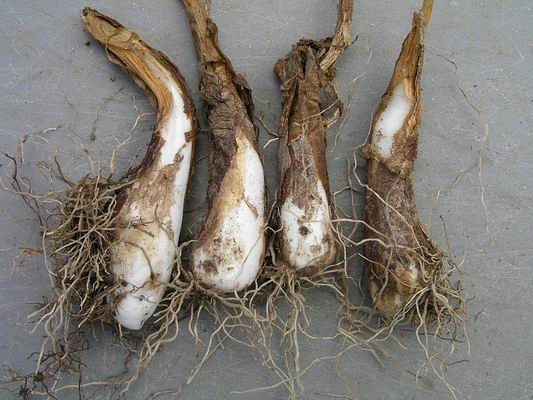
Erythronium grandiflorum bulbs
Erythronium grandiflorum bulbs are very white and do not obviously produce the same chain type structure. I have never found any offsetting at all on our forms of grandiflorum; we can only increase them by seed and hope that one day we will raise one that will oblige us.
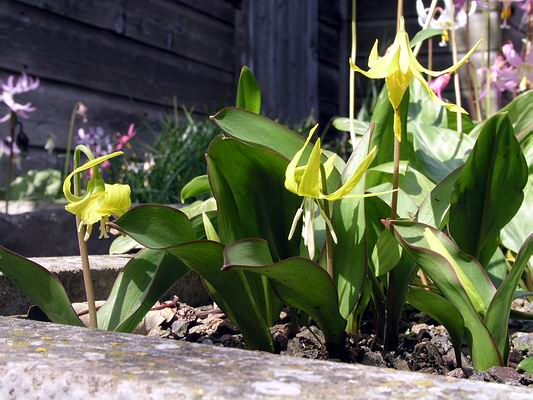
Erythronium grandiflorum
This is the same basket in flower, it was seed raised from other plants in our garden that also exhibit the purple lined edge to the leaves and the pale cream coloured pollen.

Erythronium grandiflorum pollen colour
This group of Erythronium grandiflorum were raised from a wild collection of seed and, you will note, has forms with yellow pollen and others with dark pollen. The three different colours of pollen are given varietal status; the dark red form being the type, with var. pallidum and var chrysandum given to the pale cream and yellow forms respectively. These plants do not have the purple line around the edges of the leaves. It has stopped raining now so I am off to repot more bulbs.
^ back to the top ^
|

